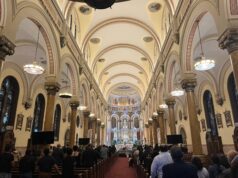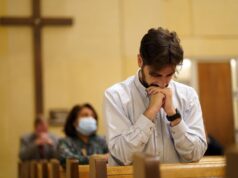
A research library at an Ohio university houses what it calls “the largest dedicated collection of materials on Mary in the world” — and its doors are as open as the Blessed Mother’s arms.
“We are here for everyone, including people with a personal devotion, artists looking for inspiration, academics and theologians,” Sarah Cahalan, executive director of the Marian Library at the University of Dayton in Dayton, Ohio, told OSV News.
Founded in 1943, the Marian Library lives up to its motto of “De Maria numquam satis” (“Never enough about Mary”). Its books, periodicals, articles, prints and religious artifacts — combined with resources in an array of disciplines, including patristics, biblical studies, church history, spirituality, hymnography and iconography — represent 100 languages and form an impressive repository that only one institution can match, said Cahalan.
“It’s not a competition, but obviously the Vatican had a significant head start,” she admitted.
The library, which supports a number of Marian studies programs offered by the school, led to the creation of the International Marian Research Institute, which hosts the online Marian Forum to promote academic research on Mary. Institute graduate and former faculty member Archbishop Frank Leo now heads the Archdiocese of Toronto, which he entrusted to the Immaculate Heart of Mary.
Currently, the Marian Library is hosting the two-part art exhibit “East Meets West,” which features a private collection of Ukrainian works by women icon makers of the Lviv School in Ukraine, along with selections from the library’s own Ukrainian Marian Collection, which was established in 1981 by Marian Library employee Helen (Halyna) Nykolyshy.
For Nykolyshy, who died in 2000, assembling the Ukrainian Marian Collection was a “passion project,” said Cahalan. “Her family had to leave Ukraine because of religious persecution, and her work has become increasingly relevant again.”
The Lviv School women iconographers have brought a contemporary vision to the genre, employing “distinctive styles, color schemes and really interesting (techniques) that people have responded well to,” said Cahalan.
Seeing Mary through fresh eyes is a goal of the Marian Library, one that informs its acquisitions policy, she said.
Cahalan and her colleagues seek to incorporate “more geographic diversity” in the library’s materials by adding pieces from African, Indigenous and other cultures.
“We are actively working to acquire materials that demonstrate the global reach of devotion to Mary, and give a more comprehensive overview of what that devotion looks like today,” she said, pointing to Our Lady of Kibeho, Rwanda — the only Vatican-approved Marian apparition in Africa — as one example.
With “a majority of its material Catholic” in nature, the library is also making “a concerted effort in recent years to show how Mary is presented in other traditions, such as Islam, which is important for ecumenism and interfaith dialogue,” said Cahalan.
Even a few works by Marian detractors, such as “17th-century Protestant authors writing against Catholicism,” can be found on the library’s shelves, she said.
The collection also has its share of the whimsical, said Cahalan.
“One of the fun things about Catholicism is that in addition to high art, we certainly churn out a lot of kitsch,” she said.
The library’s Nativity set collection in particular is “an area where people really do let their creativity emerge,” Cahalan said. “We have unconventional animals in the displays that never would have been in Bethlehem 2,000 years ago. And we had one artist who used kitchen implements (for the figures), with the Infant Jesus made from a strawberry huller.”
Mary might smile at such humble innovations — and she herself serves as “a bridge” that connects others, especially the marginalized, to each other, said Cahalan.
“She has a way of drawing people closer to her,” Cahalan said. “She’s strong, brave and courageous, but also known for her humility. I hope we’re doing work that makes her proud.”








